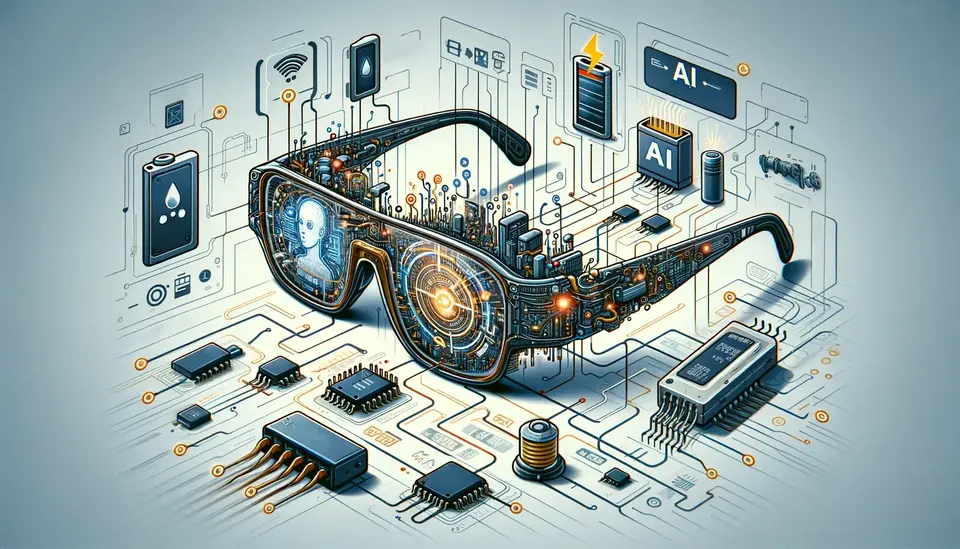Why are companies investing in Smart Glasses?
Posted on April 16, 2024 7 minutes 1365 words
Table of contents
Introduction
In recent years, the concept of smart glasses has transitioned from speculative fiction to marketable reality, capturing the imagination of innovators and consumers alike. These devices, which overlay digital information onto the physical world, represent a significant leap forward in wearable technology. With major tech giants and numerous startups ramping up their investments in smart glasses, it’s clear that this technology is poised for widespread adoption. This blog post explores the multifaceted reasons behind the surge in corporate interest in smart glasses, detailing how these devices enhance operational efficiency, open new revenue streams, and offer substantial competitive advantages.
Technological Advancements
Hardware and Software Innovations
Smart glasses represent a leap forward in wearable technology, merging cutting-edge hardware and software to create a seamless augmented reality (AR) experience. Innovations in micro-display optics and high-density batteries packed into a lightweight, wearable format allow users to enjoy enhanced visuals without compromising on comfort or usability. Advances in AR capabilities enable real-time data overlay, which can display crucial information directly in the user’s field of vision, enhancing both efficiency and experience.
Integration with Existing Technologies
A key factor driving the investment in smart glasses is their ability to integrate smoothly with existing technological ecosystems. For instance, smart glasses that sync effortlessly with smartphones, tablets, and even enterprise software systems can significantly amplify productivity. This integration allows for a range of functionalities, from real-time notifications and GPS navigation to specialized applications like remote expert assistance and interactive training modules.
Business Incentives
Productivity Improvements
Companies are investing in smart glasses mainly due to the substantial gains in productivity these devices offer. In sectors such as manufacturing and logistics, smart glasses provide employees with hands-free instructions and guidance, reducing the time taken to complete tasks and minimizing errors. For example, a worker in a warehouse can receive real-time information about package sorting and inventory management directly through their vision, speeding up the process and improving accuracy.
Cost Reduction
Over the long term, smart glasses can lead to significant cost savings for businesses. By optimizing processes and reducing errors, these devices decrease the need for extensive training periods and costly mistakes. Additionally, the ability to perform remote troubleshooting and assistance cuts down on travel expenses and time lost, further enhancing the cost-effectiveness of smart glasses.
New Revenue Streams
Beyond improving existing operations, smart glasses open up new avenues for revenue generation. This includes everything from enhanced service offerings (like augmented reality experiences in retail) to entirely new products designed around AR technologies. Companies that innovate early in this space can capture significant market share in a burgeoning industry, setting a foundation for future success as the technology matures.
Case Studies
Successful Implementations
One of the strongest arguments in favor of smart glasses is the real-world success stories from early adopters. For example, DHL, the international courier and logistics company, implemented smart glasses in its warehouses for ‘vision picking.’ The results were a 15% increase in operational efficiency and enhanced accuracy in order fulfillment. Similarly, Boeing has used AR glasses to assist technicians in airplane wiring harnesses, significantly reducing errors and cutting production time by 25%.
Industry Variety
The versatility of smart glasses is evident in their wide range of applications across different sectors:
- Healthcare: Surgeons use AR glasses to access real-time diagnostics and patient data during procedures.
- Education: Interactive learning experiences with AR can engage students more effectively than traditional methods.
- Tourism and Travel: Enhancing tourist experiences with real-time contextual information about landmarks and navigation assistance.

Consumer Trends
Increasing Adoption
The consumer market for smart glasses is rapidly expanding. Recent surveys indicate that as much as 32% of consumers in technology-savvy markets are open to using AR glasses as part of their daily lives. This trend is supported by the increasing popularity of mixed reality experiences, which blend the digital and real worlds in ways previously only imagined in science fiction.
Market Research
Market research by firms like IDC and Gartner highlights a growing interest in smart glasses, predicting that the global market could grow by 70% annually over the next five years. This research typically points to the high engagement levels of AR applications and the potential for these devices to become as ubiquitous as smartphones over the next decade.
Demographic Breakdown
Interest in smart glasses transcends age groups but is particularly high among Millennials and Generation Z, who are more comfortable with wearable technology. These demographic segments value the ability to access digital content hands-free and on the go, which smart glasses provide. Moreover, the ability to customize and personalize the AR experience appeals strongly to these groups, who prefer products that can adapt to their lifestyle and preferences.
Competitive Advantage
First Mover Advantage
Companies that invest early in smart glasses technology can establish themselves as market leaders. Being a first mover in this rapidly evolving field provides a strategic advantage in branding and sets a benchmark for innovation. Google, despite the initial commercial stumbling of Google Glass, gathered invaluable insights into user behavior and technological limitations, which can be leveraged in future iterations or different tech ventures.
Brand Differentiation
Smart glasses offer unique differentiation in crowded markets. By integrating AR capabilities, companies can offer customers unique experiences that are not possible with smartphones or traditional digital interfaces. For example, a retail company can use AR glasses to enhance the shopping experience by providing virtual try-ons, navigation through stores, and instant access to product information, thereby differentiating their brand from competitors.
Future Outlook
Potential Growth
The potential for growth in the smart glasses market is immense. Analysts predict that by 2030, the global market for AR and VR technologies will exceed $30 billion. The integration of AI with AR, improving both the functionality and user experience of smart glasses, will be a critical driver of this growth.
Evolving Technologies
Technological advancements will continually enhance the capabilities and reduce the limitations of smart glasses. Future generations of smart glasses are expected to be more powerful, less obtrusive, and offer better integration with other IoT devices, further increasing their appeal and utility.
Regulatory Considerations
As with any disruptive technology, smart glasses will face regulatory scrutiny, especially concerning privacy and data security. How companies navigate these challenges will be crucial for widespread adoption. Clear, transparent communication about how user data is collected, used, and protected will help mitigate privacy concerns and build trust with users.
Challenges and Controversies
Privacy Concerns
Privacy remains the most significant barrier to adoption for smart glasses. Users and regulators alike are concerned about how these devices could potentially record and transmit personal information without consent. Companies must design smart glasses with privacy in mind, such as implementing features that indicate when recording is taking place.
Technical Limitations
Current smart glasses still face significant technical challenges, including limited battery life, image resolution, and field of view. These issues can detract from the user experience and limit the functionality of the device, thereby hindering broader consumer adoption.
Market Skepticism
Despite their potential, there is considerable skepticism about the viability of smart glasses as a mainstream product. Past failures, such as Google Glass, have made consumers and investors wary. Overcoming this skepticism will require not only technological improvements but also effective marketing strategies to highlight the practical benefits of smart glasses.
Conclusion
Smart glasses stand at the confluence of innovation and practicality, offering a glimpse into a future where digital and physical realms merge seamlessly. The investment surge in this technology by companies across various industries is not only a bet on their current utility but also a strategic move to shape the future landscape of digital interaction. As we’ve explored, the advantages ranging from improved workplace productivity and new business opportunities to competitive differentiation make a compelling case for their adoption. However, the journey is not without challenges. Privacy concerns, technical limitations, and market skepticism are hurdles that need to be overcome. Companies that navigate these issues effectively while leveraging evolving technologies could not only reap immense benefits but also define the path forward for this exciting field. As smart glasses continue to evolve, they will undoubtedly transform our way of living, working, and interacting with the world around us.








